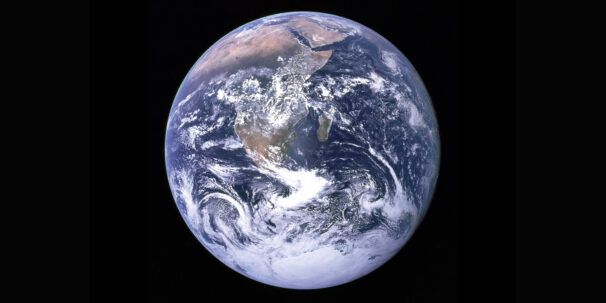Earth Day: Is Spaceship Earth heading for environmental disaster?
Explore how systems thinking could help us avoid environmental disaster in this Earth Day guest post by Professor Tom Oliver.

This Earth Day, Professor Tom Oliver from the University of Reading explains how a new way of thinking is already having an impact on the way policymakers, environmental organisations and wildlife charities are approaching the interlinked climate and biodiversity crisis we face.
In this article, discover how preventing environmental disaster needs more than just technological fixes. It also requires deeper changes to our mindsets and worldviews, which is a key insight from ‘systems thinking’.
Earth from outer space
Hold a small garden pea in the palm of your hand and imagine it’s Planet Earth. At that scale, everything alive right now – 8 billion humans and trillions of animals and plants – would exist on an ultra-thin surface layer around 0.03 mm thick. That tiny sphere in your hand, with its rare and delicate conditions so conducive to life, is now under threat.
If you were standing in central London holding that pea-sized earth, the sun would be 1,500 km away, a little further than Warsaw, Poland. Even at that scale, the nearest planet outside our solar system would be 397 million km away.
Despite the optimism of certain technophiles who hope we’ll colonise other worlds to avoid ecological catastrophe on our own, this planet remains our only home for the foreseeable future. If we fail to reverse its environmental degradation, we threaten the survival of thousands of species, including us.

The idea of Earth as some kind of ‘spaceship’ was raised in a 1965 speech by the United States Ambassador to the United Nations, Adlai Stevenson, who said:
“We travel together, passengers on a little spaceship, dependent on its vulnerable reserves of air and soil; all committed for our safety to its security and peace; preserved from annihilation only by the care, the work, and, I will say, the love we give our fragile craft.”
As a concept, Spaceship Earth suggests we humans take an active role in steering planetary processes. We can’t avoid major consequences from the activity of nearly 8 billion humans, but we can make them positive, to navigate this planetary vessel more wisely.
Currently, our human industries pollute the Earth’s atmosphere, oceans and soils, driving a sixth global mass extinction. We are disrupting major Earth system processes, such as the carbon, nitrogen and water cycles. As a consequence, our Earth is heading for environmental disaster, and we must take a more intentional role in steering it on a safer course.




Will technology solve our environmental problems?
Spaceships are reliant on technology, and talking about the Earth in this way might imply that I’m advocating for grand technological fixes such as putting mirrors in space to deflect solar radiation and ‘solve’ climate change. But there are serious dangers in manipulating large-scale planetary processes using technology.
There could be many unanticipated consequences if, for example, they disrupt weather systems so that people struggle to grow food. Similarly, creating robotic drones to address the crop pollination crisis could lead to the inadvertent loss of many birds and wildflowers which contribute to ecosystems in other ways, as well as through pollination.
Steering a safer course with systems thinking
So, although I think technology has a role to play, when we’re trying to think of climate solutions to our planetary polycrisis, we need to step back and look at the bigger picture. Systems thinking is a set of knowledge and tools that helps us do this.
It enables us to hold multiple desired outcomes in our mind at once (avoiding ‘blinkered thinking’) to better navigate the trade-offs that occur between objectives. This helps prevent our solutions to one aspect of the planetary crisis – climate change for example – from having adverse effects on other outcomes we care about, such as biodiversity, clean water and air.
Systems thinking is more than just assessing trade-offs and synergies. It’s also about considering the multiple perspectives and values of all the stakeholders involved in a problem. Coming back to the analogy we started with, a spaceship isn’t all about technology. It has a crew made up of diverse individuals who must join forces to achieve a common goal.
Another advocate of the Spaceship Earth concept, Buckminster Fuller described human beings as the crew of a large spaceship needing to work together to keep it functioning properly. To do this, they need a sense of unity and a shared vision. Such a vision must celebrate a diversity of values, yet also somehow suppress anti-social behaviour and ecocide that would threaten the spacecraft’s integrity.
The path to a better future
Systems thinking includes techniques to better understand the hidden influences of mindsets and culture on our decisions. It has the power to actively steer society towards more sustainable outcomes and away from environmental disaster. Psychological studies suggest that modern society has become dominated by more materialistic and individualistic attitudes which have harmful consequences for the planet.
So, perhaps the time is right for a more collectivist culture that is more mindful of the needs of other people and species, including future generations. Could this be a more successful way to crew Spaceship Earth and avoid environmental disaster?
There are important lessons we can learn from ancient and indigenous cultures too, though we must ultimately develop a new vision for the modern world. Any group identity might need to extend beyond nation-states to gain a sense of global citizenship, maybe even including solidarity with other species beyond humans.
In my course, Using Systems Thinking to Tackle the Climate and Biodiversity Crisis, I interviewed Sir Bob Watson, previous chair of the Intergovernmental Panel for Climate Change (IPCC). Professor Watson said:
“For a long while we tended to focus on technological solutions, especially in climate change with the IPCC. I think now, over the last, say, 10 years, I think it’s become quite clear that … all of the issues are interconnected: climate change, loss of biodiversity, pollution, land degradation. We also now realise these are no longer simply environmental issues, they’re development issues, economic issues, social, security, moral and ethical issues, and they all have to be dealt with together.”
“And unless you deal with these so-called environmental issues, you can’t reach any or achieve any of the UN Sustainable Development Goals: food security, water security and human health for everybody. And I think that we now realise that technical solutions alone will not solve it.”
What can I do about the biodiversity and climate crisis?
- Discover how systems thinking can give you a deeper understanding of the underlying role of mindsets and culture in understanding your own actions.
- Learn how to avoid proposing superficial fixes to the complex environmental problems the world now faces.
- Hear from environmental policymakers and conservation organisations about the ways they’re working to understand the link between people’s mindsets and their actions, in order to address issues.
- Practice analysing complex problems using a free systems mapping tool, explore the interlinked nature of issues that affect you, and share your thoughts and ideas with other learners.
Start exploring biodiversity and climate solutions today
Systems thinking is perhaps the surest way to safely navigate our Spaceship Earth through a perilous Anthropocene era. And it’s not only valuable for governments and organisations. Some of the principles and methods can help us manage the environmental challenges we face in our own lives.
Whether you like the Spaceship Earth concept or not, I hope you will agree that to achieve meaningful and lasting change on environmental issues, we need a collective approach to tackling the climate and biodiversity crisis, which requires all of us to shift our values, mindsets, and worldviews.
Even if you don’t agree, come along and join in the discussions on the Systems Thinking course! You can learn from others and share your own insights about the value of systems thinking to develop a new way of seeing and understanding environmental issues.
Together, we can radically change how we go about tackling these problems, avoiding environmental disaster and navigating a more sustainable course for our planetary home.








